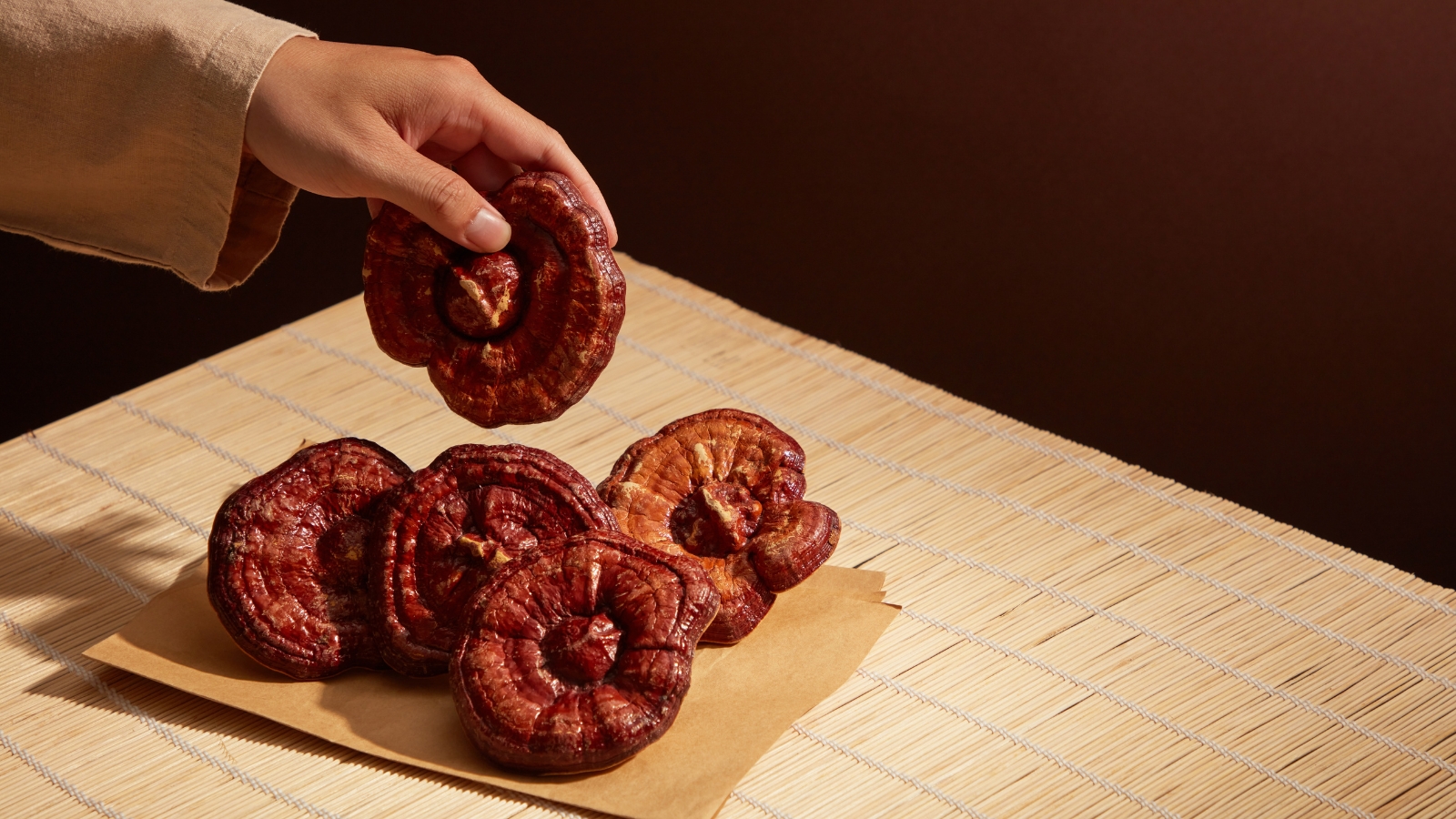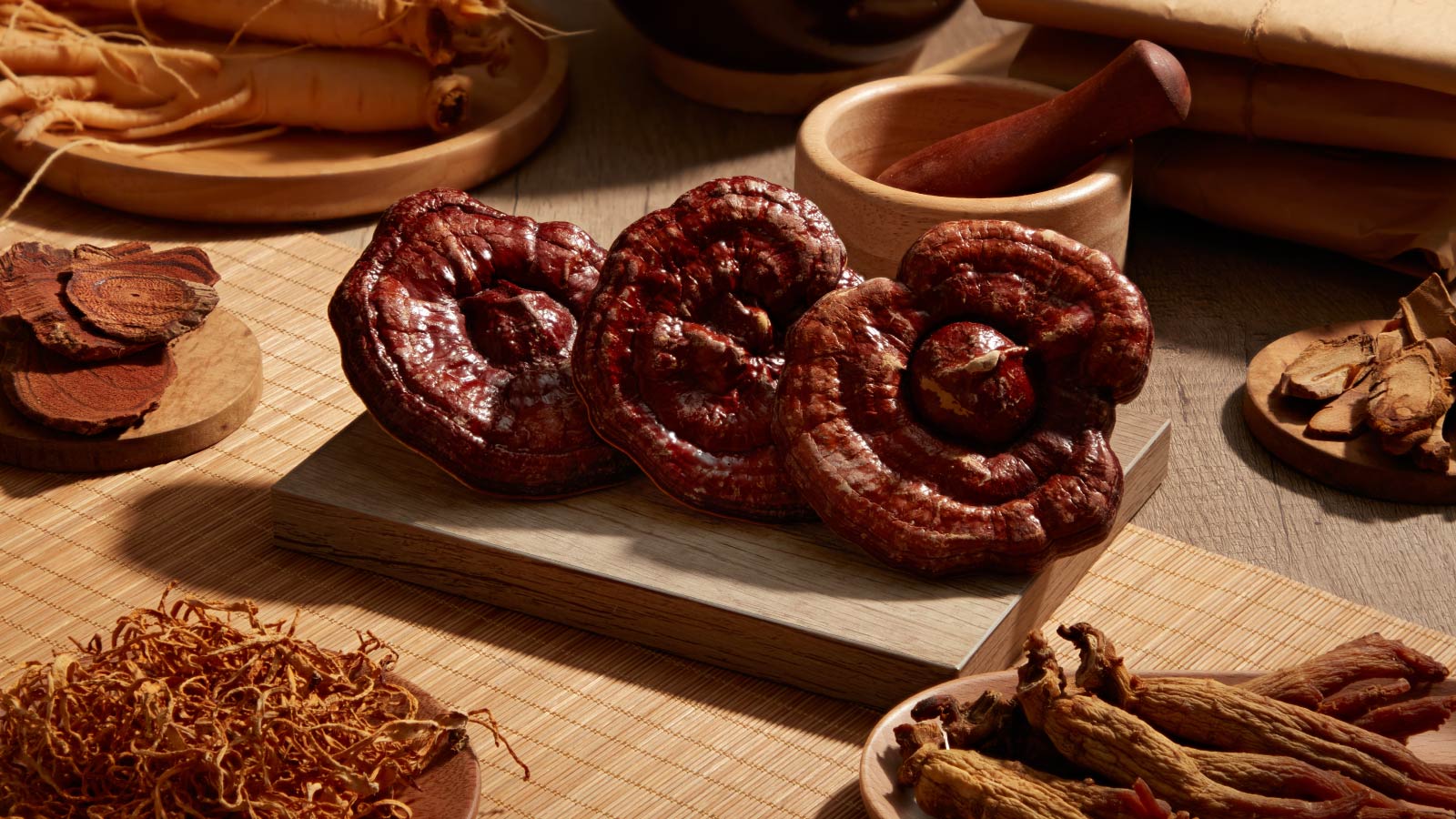Embark on a journey through time and culture with the Reishi mushroom, a symbol of longevity and health that has captivated humanity for millennia. Known as the “Mushroom of Immortality,” Reishi is not just a fungus; it’s a historical and cultural marvel.
This guide explores the ancient roots of Reishi mushrooms and their widespread cultural significance, revealing how this remarkable mushroom has been revered and utilized across various civilizations. And, what benefits it can bring to your wellness regimen.

History and Origin
From the dense forests of Asia to the Western wellness circles, Reishi’s journey is a testament to its enduring allure. Reishi mushrooms, or Lingzhi in Chinese, were highly valued in traditional Chinese medicine, often reserved for royalty due to their scarcity and reputed health benefits.
They were referred to as the “elixir of immortality” or the “mushroom of spiritual potency” due to their believed ability to promote longevity, vitality, and spiritual well-being.
Beyond its origin in Asia, Reishi’s influence extends globally, marking its presence in art, literature, and traditional healing practices worldwide. This global embrace of Reishi reflects a universal quest for wellness and a deep reverence for nature’s healing powers.
Biological Overview
Reishi mushrooms, scientifically known as Ganoderma lucidum, are a remarkable species in the world of mycology, distinguished by their unique properties and biological characteristics. From a scientific standpoint, Reishi mushrooms are a goldmine of bioactive compounds, each contributing to their therapeutic potential.
One of the most striking features of the Reishi mushroom is its adaptability to different environments, which has allowed it to evolve a diverse array of bioactive substances. These include polysaccharides, peptidoglycans, and triterpenoids, each playing a role in the mushroom’s health-promoting abilities.
Polysaccharides, for instance, are known for their immune-modulating effects, enhancing the body’s defense mechanisms. Triterpenoids offer a range of benefits, from anti-inflammatory properties to potential anti-cancer activities.
The mushroom’s life cycle is another area of intrigue. Reishi grows predominantly on hardwoods, and its life cycle includes various stages, from spore dispersal to the development of the iconic red-capped fruiting body. The fruiting body, which is the most recognizable and utilized part, is rich in these bioactive compounds.
Species and Variants: The Different Faces of Reishi
While Ganoderma lucidum is the most commonly known species, the Reishi family includes several variants, each with its unique characteristics and habitats. The different species are often distinguished by their growing environment, morphology, and the concentration of active compounds.
- Ganoderma lucidum: Found mainly in warmer climates, this is the most studied species. It’s known for its shiny, varnished-looking cap and is often used in supplements and traditional remedies.
- Ganoderma tsugae: Commonly found in colder regions like the Northeastern United States, this species grows predominantly on coniferous trees and shares many of the bioactive properties of G. lucidum.
- Ganoderma sinense: More prevalent in China, this species is closely related to G. lucidum but differs slightly in its molecular composition and appearance.
Each species and variant of Reishi has adapted to its specific environment, which in turn influences its chemical makeup and potential health benefits. This diversity not only highlights the adaptability of the Reishi mushroom but also opens up a wide array of possibilities for its use in health and wellness.

Reishi Health Benefits
The health benefits of Reishi mushrooms are as diverse as they are significant. Rooted in ancient wisdom and backed by modern science, these benefits range from bolstering the immune system to potential cancer-fighting properties, stress reduction, and cardiovascular health improvement. Each of these areas reveals a different facet of Reishi’s therapeutic potential, making it a multifaceted tool in the realm of natural health and wellness.
Immune System Boost: How Reishi Strengthens Your Defense
Reishi mushrooms are renowned for their immune-boosting properties. They contain beta-glucans and other polysaccharides that enhance the immune system’s ability to ward off pathogens. Additionally, Reishi can modulate the immune system, balancing it to prevent overactivity, which is crucial in autoimmune diseases.
Reishi and Cancer: A Research Perspective
Research on Reishi mushrooms in cancer treatment has revealed intriguing possibilities. Studies have shown that active components like triterpenoids and polysaccharides might impact tumors, with a particular focus on lung and colorectal cancers. Clinical trials, including those in China and Japan, suggest Reishi’s potential to strengthen the immune response in lung cancer patients and reduce tumor size in colorectal cancer cases.
While these findings are promising, they primarily come from laboratory and preclinical studies. Thus, further clinical research is necessary to conclusively determine Reishi’s efficacy in cancer treatment and prevention.
Improving Sleep and Reducing Stress with Reishi
Reishi mushrooms have adaptogenic properties, helping the body manage stress more effectively. Their calming effect on the mind is conducive to better sleep quality, making them a natural remedy for insomnia and stress-related issues.
Nutritional Profile
Understanding what’s inside a Reishi mushroom and how it compares to other mushrooms and superfoods can provide deeper insights into its revered status in traditional and modern wellness practices.
Breaking Down the Nutrients: What’s Inside a Reishi Mushroom?
Reishi mushrooms are rich in bioactive compounds, including polysaccharides like beta-glucans, which are known for their immune-boosting properties. Reishi also contains triterpenes, which have been shown to have anti-inflammatory and anti-cancer effects.
Additionally, these mushrooms provide a range of essential amino acids, fiber, and vitamins like Vitamin D, which are essential for various bodily functions. Their high antioxidant content, which includes compounds like ganoderic acids, helps combat oxidative stress in the body.
Comparing Reishi to Other Mushrooms and Superfoods
Compared to other medicinal mushrooms, Reishi stands out for its unique compound profile. For instance, while Shiitake mushrooms are praised for their beta-glucans, Reishi’s triterpenes offer different health benefits like liver protection and allergy relief.
Compared to superfoods like blueberries or spinach, Reishi may not have the same vitamin and mineral density, but it offers unique bioactive compounds not found in these foods. This positions Reishi as a specialized supplement for specific health needs, complementing the broader nutritional benefits of other superfoods and mushrooms.

Cultivation and Harvesting
Cultivating Reishi mushrooms is both a science and an art, requiring precise conditions to mimic their natural habitat. Typically, Reishi grows on hardwood logs or trees, but modern cultivation often uses sterilized substrates like grains, sawdust, or wood chips.
The process involves inoculating these substrates with Reishi spores or mycelium and maintaining specific humidity, temperature, and light conditions. This controlled environment allows for consistent quality and yield. The growth cycle of Reishi from inoculation to harvest can span several months, during which careful monitoring is essential to prevent contamination and ensure healthy growth.
The harvesting of Reishi mushrooms is a critical step in determining their quality and potency. Harvesting typically occurs once the fruiting body has fully matured and before the spores are released. The timing of the harvest is crucial; too early, and the mushrooms won’t have developed their full spectrum of bioactive compounds; too late, and the spores can reduce the quality.
Post-harvest, the mushrooms are dried to preserve their medicinal properties and extend their shelf life. The drying process must be done carefully to retain the mushrooms’ active ingredients, often involving low-temperature drying techniques to prevent the degradation of sensitive compounds.
Incorporating Reishi into Your Diet
Integrating Reishi mushrooms into your diet can be a unique culinary adventure. Known for their bitter taste, Reishi mushrooms are typically not used in regular cooking like other mushrooms. However, they are excellent for making herbal teas and soups. The dried mushroom can be steeped in hot water to make a soothing tea or added to broths, imparting its earthy flavor and health benefits. Reishi can also be ground into a powder and used in various recipes, such as smoothies or chocolate bars, offering a convenient way to incorporate this superfood into daily meals.
Reishi Supplements: What You Need to Know
For those who prefer a more straightforward approach, Reishi is available in various supplement forms, including capsules, tinctures, and extracts. When choosing Reishi supplements, it’s crucial to consider the quality and source. Look for products that specify they contain the fruiting body of the mushroom, as this part contains the highest concentration of bioactive compounds.
Also, verify that the supplement has been tested for contaminants and potency. It’s important to note that while Reishi supplements are generally safe, they may interact with certain medications and are not recommended for pregnant or breastfeeding women. As with any supplement, it’s advisable to consult with a healthcare provider before adding Reishi to your regimen.

Potential Side Effects and Precautions
While Reishi mushrooms are acclaimed for their health benefits, they’re not universally suitable. Potential side effects like digestive issues, dry mouth, and dizziness can arise, especially with high or prolonged consumption. Allergic reactions are also possible, and its immune-modulating properties may be counterproductive for those with autoimmune diseases.
Crucially, Reishi can interact with medications, notably anticoagulants and immunosuppressants, potentially increasing bleeding risks or affecting drug efficacy. Therefore, individuals with health conditions, those on medication, or those considering surgery should consult healthcare professionals before using Reishi to ensure its safe integration into their health regimen.
Sustainability and Ethical Considerations
The cultivation of Reishi mushrooms, like any agricultural practice, carries environmental implications. Fortunately, Reishi can be grown sustainably, particularly when cultivated on natural substrates like wood or organic waste materials, which can be sourced from renewable forests or agricultural by-products. This method of cultivation minimizes waste and supports a more eco-friendly production cycle.
However, as the demand for Reishi increases, there is a potential risk of overharvesting wild Reishi, which could disrupt local ecosystems. Sustainable practices, such as controlled cultivation and avoiding wild harvesting in sensitive areas, are crucial in minimizing the environmental impact.
Ethical Sourcing: Finding Responsible Reishi Products
Ethical sourcing of Reishi mushrooms is essential in ensuring that the products are not only of high quality but also produced in a way that respects the environment and the communities involved in their cultivation. Consumers should look for Reishi products that are certified organic, which indicates that they are grown without harmful pesticides and in a manner that supports ecological balance.
Additionally, Fair Trade Certification can ensure that the Reishi is sourced from producers who are justly compensated and work under fair conditions. By choosing ethically sourced Reishi products, consumers can support sustainable agriculture practices and contribute to the well-being of farming communities.
Innovations and Future Trends
Recent research is redefining the role of Reishi mushrooms in health and wellness. Scientists are digging deep into their neuroprotective capabilities, exploring impacts on brain health and cognitive functions, and assessing their potential in managing metabolic disorders, like influencing blood sugar and cholesterol levels. Technological advancements in biotechnology are enabling the isolation of specific Reishi compounds, promising targeted therapies and novel supplement forms.
This progress indicates a significant shift in Reishi’s role, from traditional remedy to a potentially mainstream element in dietary supplements and alternative therapies. As the intersection of traditional knowledge and modern research continues to evolve, Reishi stands at the forefront of personalized medicine and integrative health, marking a promising future in wellness.

A Final Note
Reishi mushrooms embody a holistic approach to health, combining millennia of traditional wisdom with cutting-edge scientific research. As we’ve seen, incorporating Reishi into our daily lives requires understanding its nutritional profile, potential side effects, and the importance of ethical sourcing and sustainability.
As we move forward, the evolving role of Reishi in wellness and alternative medicine holds exciting prospects, promising to enrich our journey toward holistic health and well-being. Embracing Reishi mushrooms is not just about adding a supplement to our diet; it’s about integrating a piece of ancient wisdom into our modern lives, reminding us of the enduring power of nature in nurturing our health.















